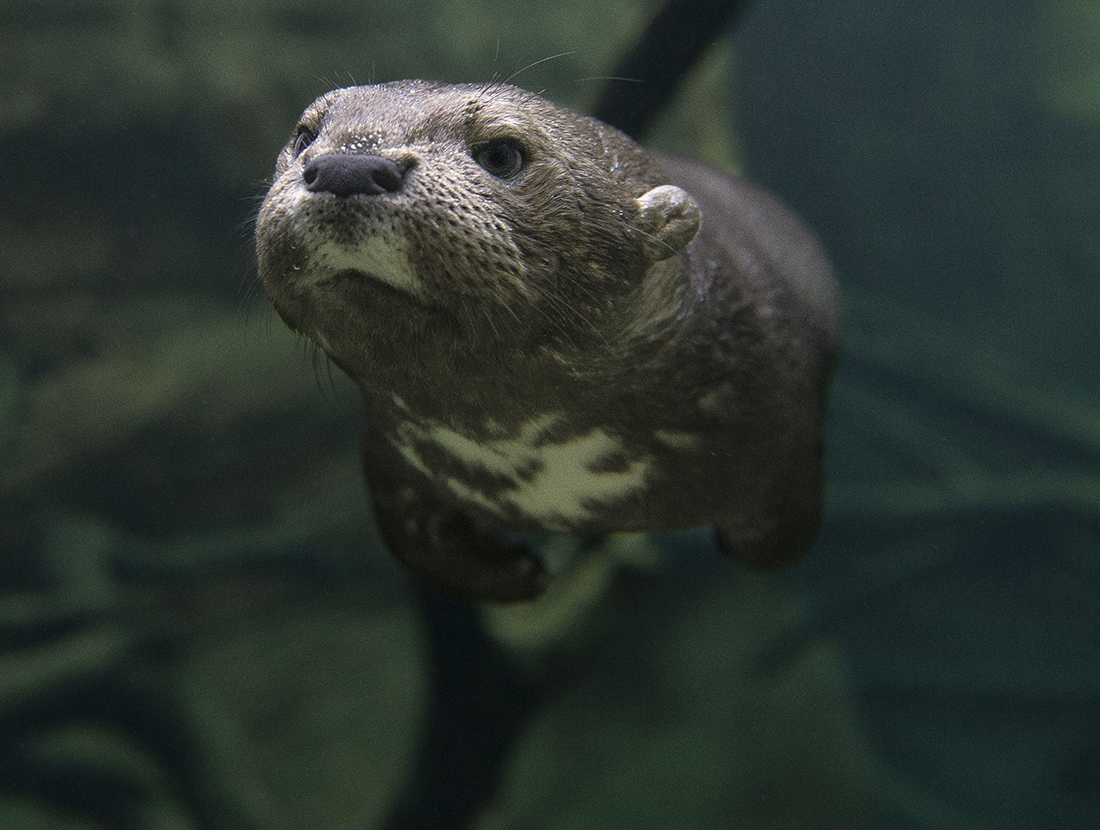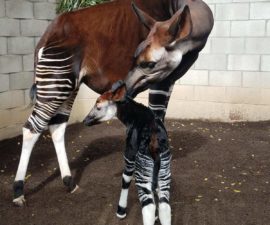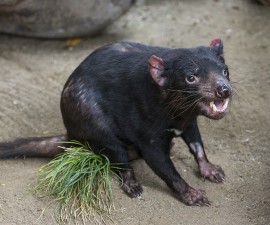BY Karyl Carmignani
Photos by Ken Bohn
Who can stay underwater for eight minutes, share a den with the local beavers, dive deep and gamely float in equal measure, eat fish and other invertebrates at every meal, and look positively adorable while doing it? The sleek and irresistible otter! Aside from its Olympic-caliber talents in lakes, rivers, and oceans, the otter also maintains a robust fan base on YouTube, with videos showing two “holding hands” while sleepily bobbing on the waves, a busy otter adroitly manipulating objects, energetic bathing, and devoted mothers ferrying their pups on their belly. Much of the photogenic attention is lavished on sea otters, but there are also 12 other otter species splashing around every continent except Antarctica and Australia.
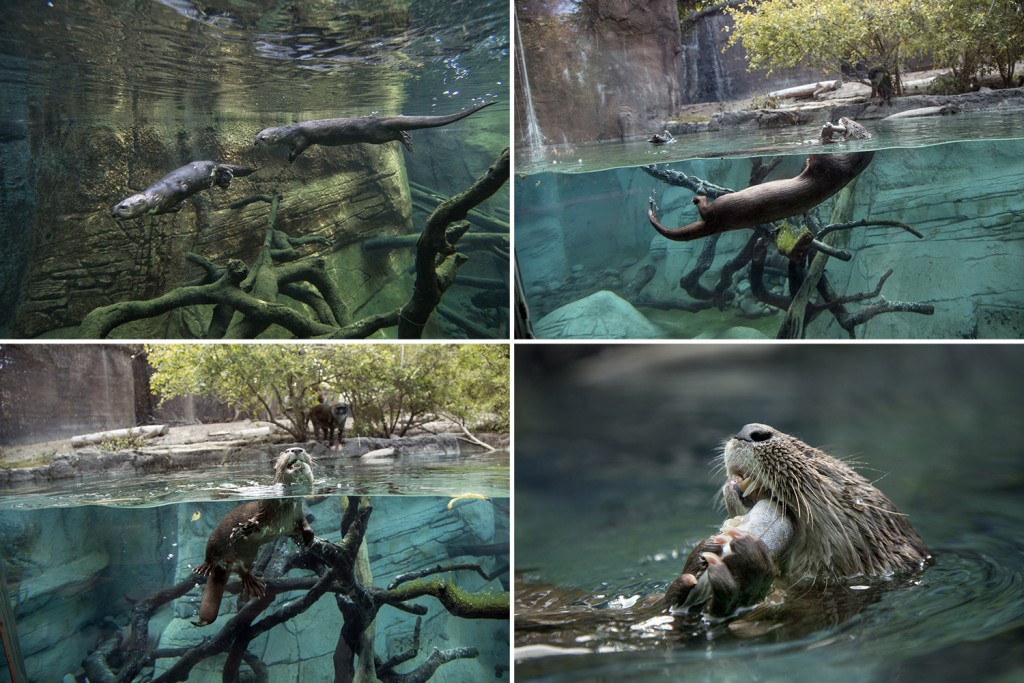
BUSY AT THE ZOO
Clockwise from top left: The otters in Ituri Forest at the Zoo are acrobatic swimmers. Look for the bubbles rising to the surface to help spot them; Swimming is a way of life for otters; Otters are able to eat on the move; A delicious snack of fresh smelt is a sure way to an otter’s heart!
Otters range in size from the endangered giant otter of South America, which can top 70 pounds and reach nearly 6 feet in length, to the Asian small-clawed otter, which is 2 to 3 feet long and weighs about 11 pounds. Sea otters are the smallest marine mammals, reaching up to five feet in length. Regardless of size, these charismatic carnivores belong to the Mustelidae family, which includes weasels, ferrets, martens, minks, badgers, and wolverines—but otters are, paws down, the best swimmers in the group. They are broadly characterized by long, streamlined bodies; fine, dense fur; and scent glands at the base of the tail. The San Diego Zoo is pleased to feature two otter species: the Cape clawless otter Aonyx capensis capensis and the spotted-necked otter Hydrictis maculiocollis.
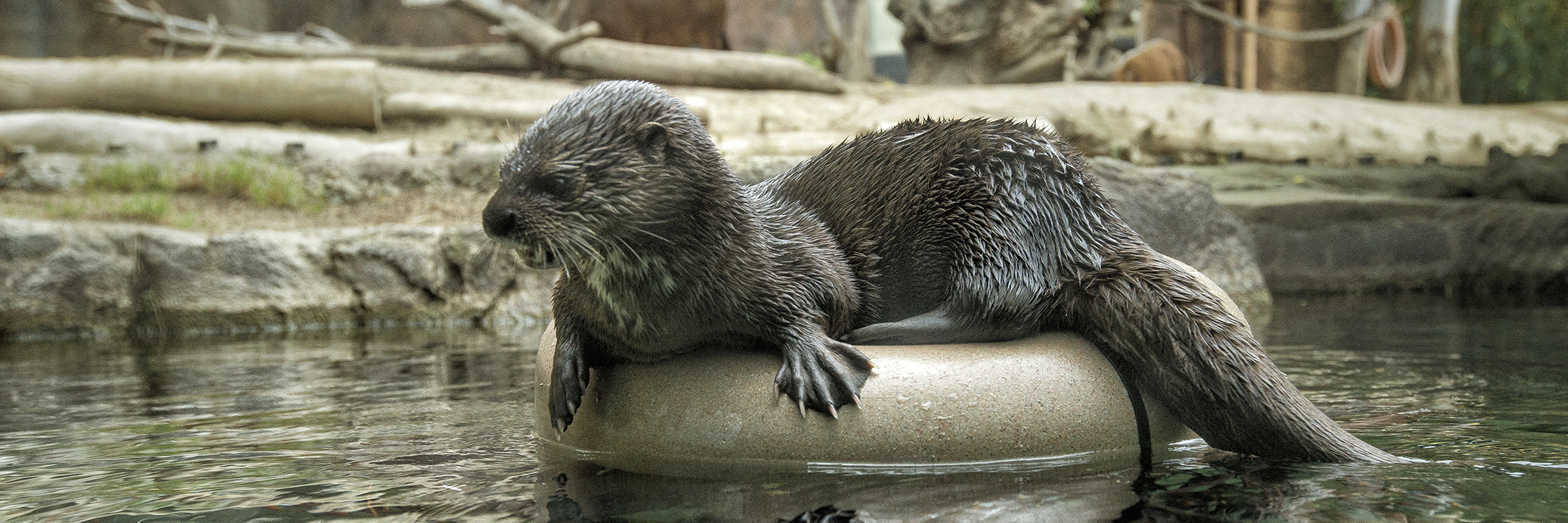
“Otterly” Fascinating
Otters are fast, fun-loving, clever creatures that never journey far from water. Sea otters are the only species that spends practically its entire life in water; other types are semi-aquatic. Sea otters are the only marine mammals that don’t rely on blubber to stay warm. Instead, they stay busy hunting to feed their rapid metabolism, and they have the densest fur of any creature on the planet. A sea otter’s impenetrable under-fur has about 1 million hairs per square inch; a dog’s coat, in comparison, has about 60,000 hairs in the same space, and a human has about 2,200 strands. Other otter species’ fur is only slightly less dense. A topcoat of long, waterproofing guard hairs keeps the undercoat dry and gives the otter a spikey, endearing appearance out of the water. Self-grooming against rocks and logs is important to keeping their coat healthy—water pollution, like oil, is life-threatening, as it can prevent otters from hunting and staying insulated.
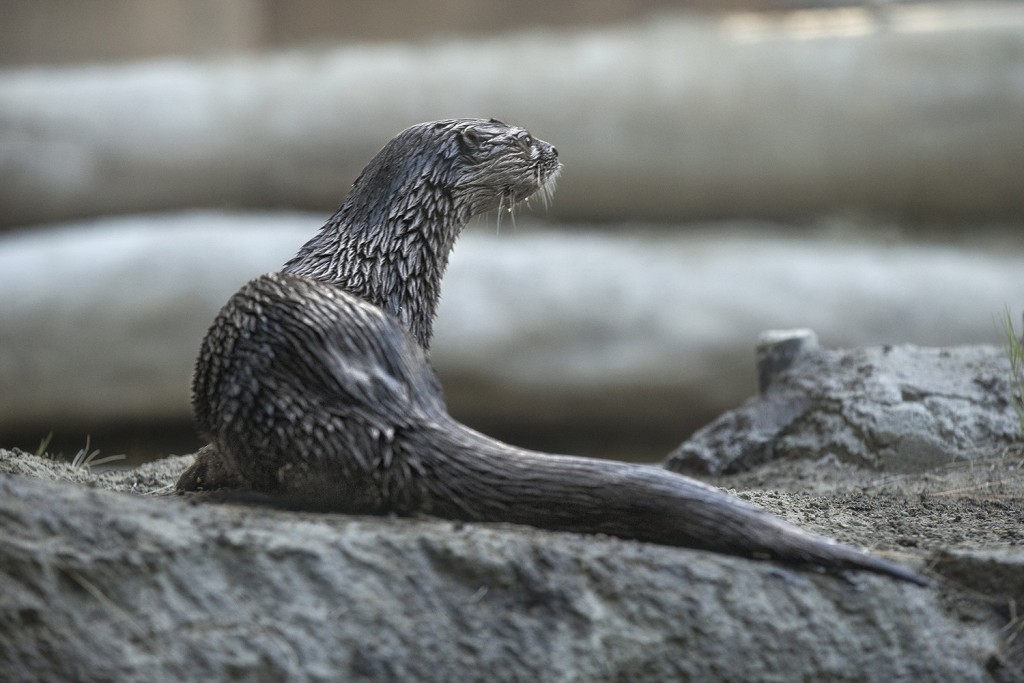
BUILT FOR WATER
A long, somewhat flattened tail is an excellent adaptation for a semiaquatic animal as it helps propel them through the water. Otters have varying levels of webbing between their toes for added propulsion.
Otters have webbed feet (some species’ toes are more webbed than others) and powerful hind limbs that are ideal for swimming. They can see just as well underwater as on the surface. All otter species except sea otters have long, muscular tails to help propel them through the water. Part of the otter’s charm and skill come from the opposable “thumbs” on its front paws, enabling it to manipulate objects much like humans do—including using specially chosen rocks to smack shells on, to get the food inside. Some types of otters catch their prey with their dexterous hands, while others use their mouths to capture a meal. They use their whiskers, called vibrissae, located above the lips, to sense changes in the water current and detect prey or predators nearby. The otter’s small, rounded ears and nostrils can close off like valves when diving underwater.

Other Word-ly
As if keen intelligence, beguiling personalities, devoted maternal behavior, and arresting good looks aren’t enough, otters are also shrouded in cool species-specific vocabulary. For instance, an otter den is called a holt. When a female is raising pups, her home is called a natal holt. Multiple animals hanging out together is called a raft or a lodge of otters. Even the otter’s scat has a special name: spraint. Social signals can be shared through urine sprayed on spraint sites. Even nicknames for otters are poetic: the marine otter of South America is also called the sea cat, giant otters are sometimes called river wolves, and the spotted-necked otter of Africa is called fisi maji, which means water hyena in Swahili. In Japanese folklore, otters are called kawauso, meaning fox—and they often outsmart humans, like the fox in American stories.
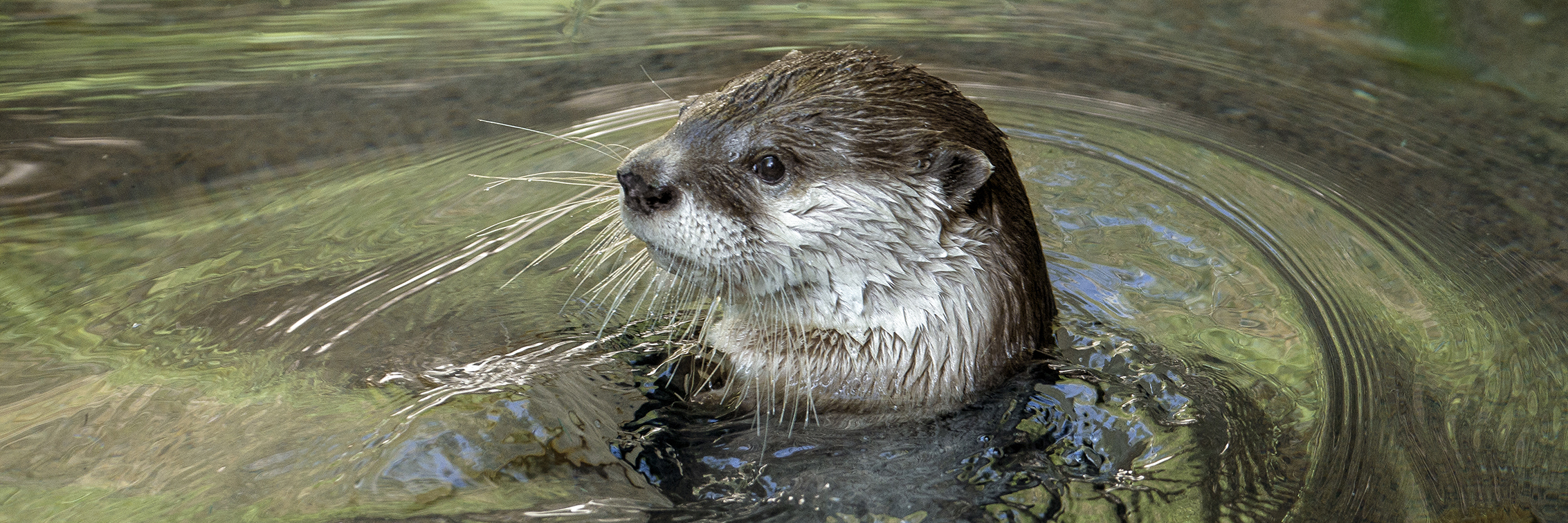
At the Zoo
While noisy monkey chases take place through the trees, a pair of spotted-necked otters scampers and glides over land and water in the Ituri Forest exhibit at the Zoo. Pori, the grande dame at 17 years old, and Mzee, the food-motivated male at 19 years old, don’t seem to have slowed down an iota in their old otter ages. Jackie Jella, senior keeper, lobs a smelt, and Mzee bolts after it. Then she drops another fish to Pori, waiting patiently below. She distracts Mzee with his fish first, so Pori can eat hers in peace. Jackie said that Mzee will even dive into the honeysuckle bushes to nab the monkeys’ food, but “his food motivation pays off during training sessions to take his blood pressure.”
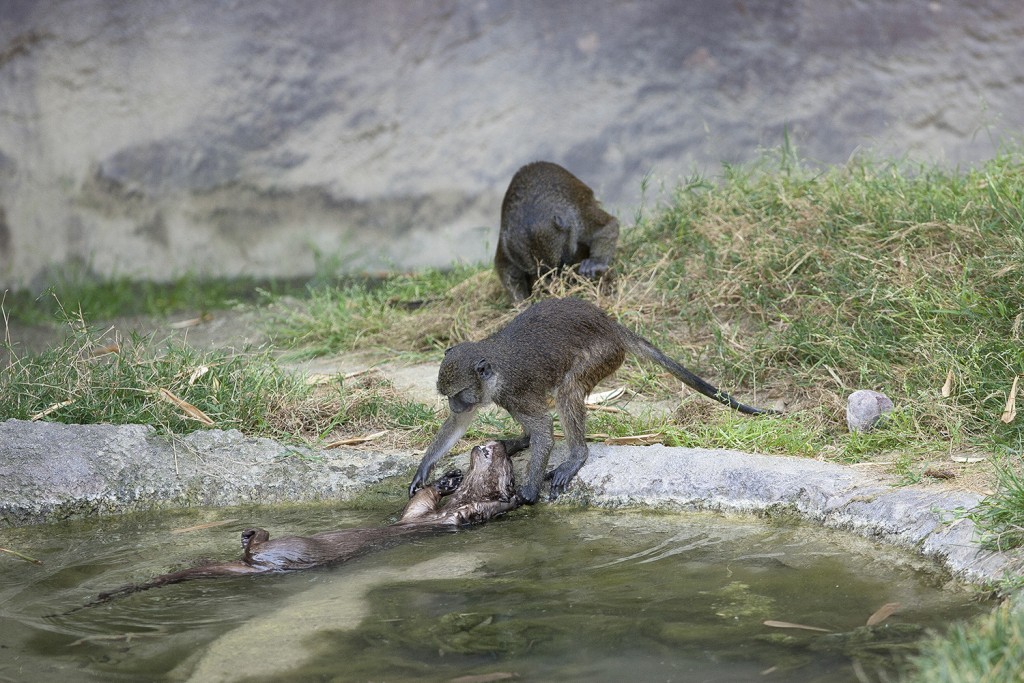
NOSE TO NOSE
Monkey lifeguard? No, this pint-sized primate is just teasing its spotted-necked otter friend!
Veterinarians diagnosed Mzee with heart disease, so keepers are training him to accept a blood pressure cuff on his tail. The otter is willing to go along with this, for a tasty price! Each of the otters is trained in basic husbandry behaviors—like placing its nose on a target, opening its mouth, presenting a paw, and rolling over—so that keepers can keep a close eye on their well-being.
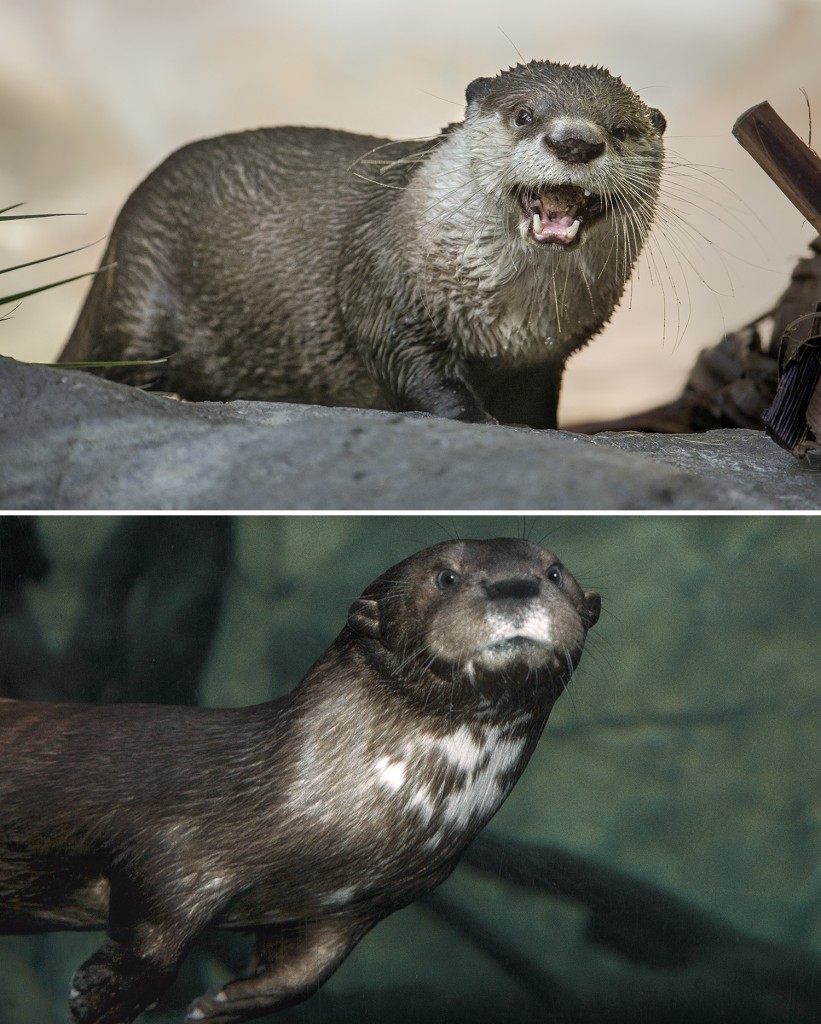
OTTER SPECIES AT THE SAN DIEGO ZOO
(TOP) Like other otter species, this Cape clawless otter can remain underwater for up to eight minutes. (BOTTOM) Spotted-necked otters are aptly named.
OTTER ENJOYMENT
Zoo visitors can meet Sweet Otter, a Cape clawless otter, on Center Street. She has an interesting history, having undergone knee surgery and several weeks of follow-up care in 2014.
On the other side of the Ituri experience, where red river hogs and forest buffalo reside, is a young pair of otters: eight-year-old Mugo and her rambunctious, one-year-old pal Heri, who is originally from Toronto. Jackie beckoned the animals with her whistle, followed by thrown fish. Mugo grasped her snack on her chest, floating on her back, and then chomped it down. Moments later, Heri was playing with a rock, dropping it underwater and diving after it. Jackie said to watch for the bubbles, and soon an otter would emerge. It seems that otter life is downright fun! Jackie explained that, compared to other otter species, spotted-necked otters are much quieter than the chattier species and less hyperactive. They are even “moody sometimes and less cooperative, and go from energetic to aloof.” She described their overall behavior as being a cross between that of a cat and a dog.
While otters may not be megafauna, they are still fascinating creatures that deserve our respect and admiration. “People may walk by them on their way to see something else,” said Jackie. “But I hope visitors will take a moment to find them and enjoy them!” They are sure to be enjoying themselves!

